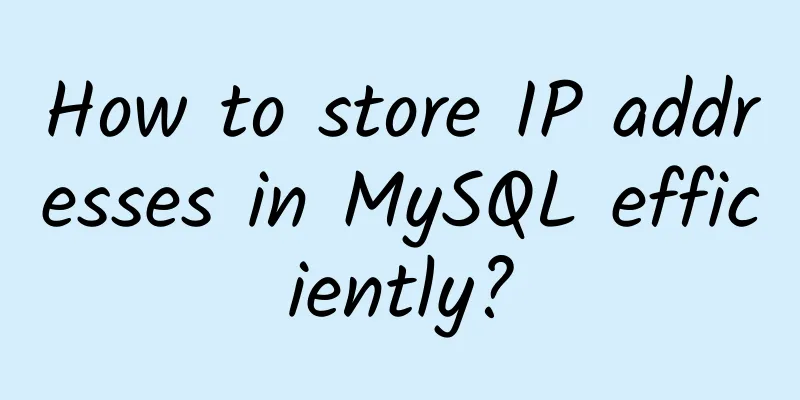How to store IP addresses in MySQL efficiently?

|
A few days ago, a friend of mine went to an interview. He came back and told me that the interviewer asked him how the IP address was stored in the database. He didn’t think much about it at the time and directly answered that it was stored in a string (thinking: Such a simple question, I’m afraid he is looking down on me) The previous paragraph is just for reference. After all, an IP address is originally a string, and it is understandable to store it in the database as a character string. However, I am a person who likes to think from the perspective of others. From the perspective of the interviewer, do you think I would ask such a low-level question? Then of course the answer is no. Therefore, what the interviewer wants to know is whether you have a deep thought about this question, and from this, to a certain extent judge whether you are just a simple "brick-moving" coder in your daily development, or a coder with soul.
Preface Regarding this question, first of all, let me state that it is completely fine to store IP addresses in the database as strings. Then you may have a question? If there is no problem, then why are you comparing it here? Although this is a contradictory topic, we have other storage methods besides storing strings. For example, the more common method is to store IP addresses as int data. Although this storage method is not complicated to implement, the fact that you can think of this method also shows that you are a good thinker and have a good grasp of the underlying data foundation. Because an int type data occupies 4 bytes, each byte is 8 bits, and its range is 0~(2^8-1), and the IPv4 address can be divided into 4 segments, each segment ranges from 0 to 255, which is just enough to be stored, so by slightly converting it, the IP address is cleverly stored in the database with the smallest space (unless otherwise specified in the following description, it refers to the IPv4 address). You may think that this small change does not matter, but when the amount of data increases, the difference between 15 bytes and 4 bytes will surprise you. So when designing a database, use the appropriate field type, just enough, and save as much as possible. As in Section 4.1.7 of High Performance MySQL 3rd Edition, the author recommends that when storing IPv4 addresses, 32-bit unsigned integers (UNSIGNED INT) should be used to store IP addresses instead of using strings. Compared with string storage, using unsigned integers for storage has the following advantages:
Usually, when saving an IPv4 address, an IPv4 address requires at least 7 characters and at most 15 characters, so VARCHAR(15) is sufficient. When MySQL saves a variable-length string, it also requires an extra byte to save the length of the string. However, if an unsigned integer is used for storage, only 4 bytes are required. In addition, 4 fields can be used to store each part of the IPv4 address separately, but usually this will not be very efficient in terms of storage space and query efficiency (although some scenarios are suitable for this storage method). However, using unsigned integers for storage also has the disadvantages of being difficult to read and requiring manual conversion. Tool class to implement conversion To store the IP address as an int type in the database, one method is to use the shift operation and & calculation in the Java code to get the corresponding value:
In fact, this is a kind of binary thinking, and it is also a number system widely used in computing technology. Although it is not used much in daily life, once you master it, it will help us strengthen our understanding of machine language and improve our coding level, especially when facing scenarios with tight resources (memory), it will help us analyze and optimize problems. Database function implementation conversion Another way is to use the database's built-in functions INET_ATON and INET_NTOA for conversion:
If it is an IPv6 address, use the functions INET6_ATON and INET6_NTOA to convert it:
Then the database is defined as varbinary type and 128 bits of space is allocated (because IPv6 uses 128 bits, 16 bytes); or defined as char type and 32 bits of space is allocated. If you use the database function, you only need to do a slight conversion when entering the IP address into the database, which is convenient and quick; and at this point, don’t you think that converting the IP address into digital storage is a good choice? After all, the database has taken this into consideration for us, and it also indirectly proves that this is indeed a feasible and good storage method. |
<<: How does 5G achieve beamforming?
>>: How can edge computing win in the context of 5G "new infrastructure"?
Recommend
How to restore blood flow to your brain after a long holiday?
[Original article from 51CTO.com] Hello, my frien...
The property management company asked for 300,000 yuan as an “entry fee” for 5G to enter the residential area. The real problem is the problems beyond technology.
The 5G waves are rising higher and higher. In ear...
AI technology trends that matter to businesses
According to the 2020 McKinsey Global Artificial ...
During the COVID-19 pandemic, F5 ensures safe and stable remote work for Lancashire hospitals in the UK
Lancashire Teaching Hospitals NHS Foundation Trus...
Talk about Kerberos kinit command and ccache mechanism
1. Introduction Hello everyone, I recently encoun...
"Connecting Everything with Light, Sense the Extraordinary" Huawei held a seminar for core partners of industry perception distribution
On May 10, Huawei's Industry Perception Distr...
How to truly experience 1G internet speed in the 5G era? WiFi has become an important help!
According to statistics, 20% of the sites in hots...
Google reports: CBRS deployments doubled from March to April
Google says demand for 3.5 GHz Citizens Broadband...
5G service routines for users have caused consumers to have more doubts about 5G
While the industry has painted many bright prospe...
drServer: Dallas unlimited dedicated servers starting at $12/month
drServer is a foreign hosting company founded in ...
Vietnam's three major operators reach 5G RAN equipment sharing agreement
[[404902]] Vietnam’s three largest operators, Vie...
Huawei Cloud Online Education Innovation Season is launched, 365 innovation upgrade package fully empowers education upgrade in the 5G era
[51CTO.com original article] Recently, Internet e...
The results of the 14th 51CTO China Enterprise Annual Selection are out!
[51CTO.com original article] On January 6, 2020, ...
[6.18] Alibaba Cloud: Hot-selling cloud server ECS with annual payment starting from 59.9 yuan
Every year, June 18th is an e-commerce shopping c...
The father of the Internet: The Internet is at a "critical point" and has deviated from the original idea
[[248660]] Tim Berners-Lee Beijing time, November...


![[Black Friday] spinservers: $49/month - E3-1280v5, 32G memory, 1TB NVme, 10Gbps bandwidth, San Jose/Dallas data center](/upload/images/67cabcf402984.webp)


![[Black Friday] TMThosting: VPS monthly payment up to 55% off, dedicated server 10% off, Seattle data center, Alipay support](/upload/images/67cac229924c0.webp)



